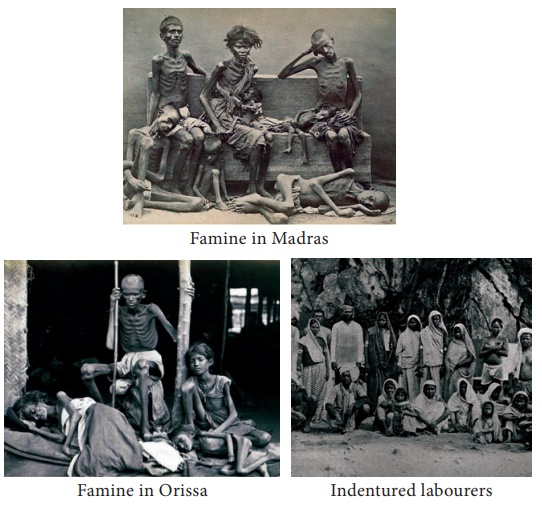Effects of British Rule - Famines and Indentured labour | 11th History : Chapter 17 : Effects of British Rule
Chapter: 11th History : Chapter 17 : Effects of British Rule
Famines and Indentured labour
Famines and Indentured labour
Famine, though no stranger to India, increased in
frequency and deadliness with the advent of British colonial rule. Between 1800
and 1825, there were only four famines. But in the last quarter of the century
there were 22 famines. It is estimated that over five million died. By 1901,
Romesh Chunder Dutt, a former ICS officer and a staunch nationalist, enumerated
10 mass famines since the 1860s, putting the total death toll at 15 million.
The laissez faire (non-intervention) principles to
which the colonial state was committed since 1833 was applied to famines also.
For years, western-educated Indians had argued that British rule was grossly
impoverishing India. The Orissa famine, in which one third of the population
died of starvation and disease, served as a patent proof of this thesis. It
prompted nationalist Dadabhai Naoroji, to begin his lifelong investigations
into Indian poverty.
An eye witness (an Englishman) of the
terrible famine in the Guntur district of Madras Presidency in 1833 said: ‘It
is dreadful to see what revolting food human beings may be driven to partake
of. Dead dogs and horses are greedily devoured by these surviving wretches; and
the other day, an unfortunate donkey having strayed from the fort, they fell
upon him like a pack of wolves, tore him limb from limb and devoured him on the
spot.’
Madras Famine of 1876-78: The failure of two
successive monsoons caused a severe famine in the Madras Presidency during 1876-78.
The viceroy Lytton adopted an hands-off approach similar to that followed in
Orissa. 3.5 million people died in the presidency.
The introduction of plantation crops and slope
cultivation in Ceylon, Mauritius, Fiji, Malaya, the Caribbean islands, Natal
and South Africa required enormous labour. Initially slave labour was used for
this purpose. But after the Company government abolished slavery in India
(1843), the system of indentured was used. Under this system, labourers were
hired on contract for a period of five years (indenture) and they could return
to their homeland with passage paid at the end. Many impoverished peasants and
weavers went hoping to earn some money. But in effect it was worse than slave
labour. The colonial state allowed agents (kanganis)
to trick or kidnap indigent landless labourers. 150 indenture labourers “the
innocent victims of a new system of slavery” were first taken from Thanjavur in
1828 to the new British coffee plantations in Ceylon. All of them deserted.
Therefore, recruitment coupled with criminal laws prohibiting desertion started
in the 1830s. People courted this new form of slavery to escape starvation
deaths.
In 1815, the Governor of Madras received a
communication from the Governor of Ceylon (Sri Lanka) asking for coolies to
work on the coffee plantations. The Madras Governor forwarded this letter to
the collector of Thanjavur, who after enquiry reported back saying that the
people were very much attached to the soil and hence unless some incentive was
provided it was not easy to make them move out of their native soil. But the
outbreak of two famines (1833 and 1843) forced the people, without any
prompting from the government, to leave for Ceylon to work as coolies in coffee
and tea plantations under indentured labour system. During 1843-1868, nearly
1.5 million people (1,444,407) had gone from Madras to Ceylon as indentured
labourers.

Indentured Labour System: It was a
penal contract system, totally differing from the contractual labour system of
the present day. According to the Indentured Labour System, the coolie (the
term applied to an Indian indentured labourer) had to work in jail-like
condition, was punishable by forfeiture of wages or imprisonment for (a)
negligence of duty or refusal to attend to work (b) insolence or disobedience
of orders or other misconduct (c) quitting service before the expiry of the
contract. By invoking one of these provisions the planters on the flimsiest
pretexts invariably either deprived the labourers of their wages or put them
behind bars. The contract prohibited the formation of associations by coolies
either with the objective of claiming increase in wages or for termination of
their contract. The Plight of women in plantations is described poignanatly in
Bharati’s famous song ‘Karumbu thottathile’
Drain of Wealth
Dadabhai Naoroji in his Poverty and Un-British Rule in India explained how the English rulers were different from the earlier invaders. He said, in the case of former foreign invaders, they plundered and went back. They made, no doubt, great wounds, but India, with her industry, revived and healed the wounds.
When the invaders became rulers of the country they settled down in it; whatever was the condition of their rule,
there was at least no material or moral drain in the county. But with the
English the case was different. There are the great wounds of the first wars in
the burden of the public debt and those wounds are kept perpetually open and
widening by draining away the lifeblood in a continuous stream. The former
rulers were like butchers hacking here and there, but the English with their
scientific scalpel cut to the very heart, and yet, there is no wound to be
seen, and soon the plaster of the high talk of civilization, progress and what
not covers up the wound.
Naoroji argued that a great deal of wealth was
drained to England in the form of Home Charges. The following constituted the
Home Charges:

·
Incentive to the shareholders
of the Company
·
Savings and the salaries of European officials, European traders and Planters remitted to England.
·
Pensions to those who retired from civil and military services.
·
The salaries of the staff and the Secretary to Home Government, India Office at London
·
Expenses on wars fought in India and interests for the loans obtained from the banks for the conduct of
wars and for the building of railroads.
India’s loan to England was 130 million pounds in
1837. It increased to 220 million pounds, of this 18 percent was for conducting
wars waged against Afghanistan and Burma. A government report of 1908 informed
that on account of railways, India had incurred a debt of 177.5 million pounds.
In order to give outlet to the saturated capital the British secured the
capital from private enterprise in England. In the form of guaranteed interest
of 5 percent, the Colonial state promised to repay the interest in sterling.
There was a loss of 220 million pounds to India on this score.
Calling this as drain of wealth Dadabhai Naoroji
lamented that had the money drained to England remained in the pockets of
Indians, India would have economically progressed. Even Gazni Mahmud’s pillage
stopped after eighteen times but the British plunder seemed to be unending, he
quipped. R.C. Dutt estimated that during the last decade of the reign of Queen
Victoria (1891-1901), of the total income 647 pounds, 159 million pounds
drained to England. This worked to 44 percent of the total income of the
country.
Related Topics